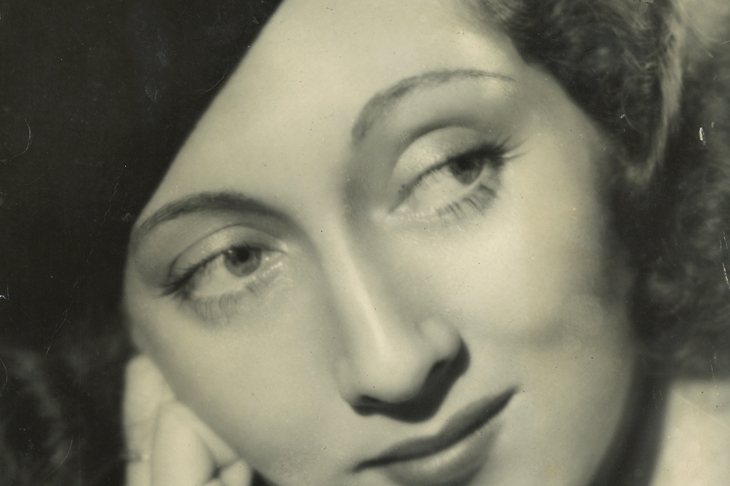Anita Leslie knew how to tell a story. Arranging to sit for a portrait six months before she died, she planned to borrow a khaki shirt on which to pin her second world war decorations, the Africa Star and the Croix de Guerre. The portrait was never commissioned, but it is clear that Leslie — the only woman to have been awarded both these honours — wanted to be remembered as a war heroine, as well as a biographer, memoirist, witty and well-connected socialite, and cousin of Winston Churchill. Leslie’s war work certainly merits greater attention, so it is a shame that Penny Perrick’s Telling Tales: The Fabulous Lives of Anita Leslie focuses so much more on the ‘low-down on the high-ups’ than her subject’s actions on the front line.
Born in 1914, Leslie endured a ‘privileged but unpleasant’ childhood. With her upper-class Anglo-Irish parents focused on their own lives, she quickly grew to associate happiness with the freedom she found at the family estate, Castle Leslie, and misery with her series of boarding schools. Never comfortable among ‘intellectuals’, she would always prefer ‘empty-headed but amusing quality folk’. This is a book peopled by horsey young men, and women with names like Winifred ‘Pooh’ Paget, all looking charming, writing amusing letters, avoiding taxes and enjoying bedroom-hopping ‘roguey-poguey’.
Mainly to annoy her mother, in 1937 Leslie married Colonel Paul Rodzianko, a once-wealthy nobleman 30 years her senior, dispossessed by the Russian revolution. Rodzianko, who had identified the remains of Tsar Nicholas II’s pet dog by its bloodstained collar at Ekaterinburg, was a brilliant riding instructor and could slice off champagne corks with his sword. He was also violent, demanding and deeply anti-Semitic — a trait, Perrick writes, that he ‘transferred to his young wife’.
In fact Leslie already shared the ‘casual’ anti-Semitism of many in her circle. In August 1938 she hoped to visit Nuremberg as a guest of Hitler, feeling it would be ‘rather fun to meet all the Nazis’. That October she considered working in propaganda, where she could produce ‘anti-Jew stuff’, and even after Kristallnacht she was pleased to entertain Unity Mitford, noting that her husband was looking forward to meeting someone ‘who really likes Hitler as much as he does’. ‘It is difficult to excuse anti-Semitism,’ Perrick writes, before unfortunately noting that Leslie was not encouraged to ‘think deeply’, and envied Jews ‘for being cleverer than her and better at making money’.
The war brought new opportunities and fresh perspectives. Attracted by both the beautifully tailored uniforms designed by Hardy Amies, and the chance to escape her abusive husband, Leslie joined the Mechanised Transport Corps. The next few years took her from southern Africa — ‘don’t get sunburnt… men hate it’, her mother advised — to the Middle East, where she delivered copies of the first English newspaper to the troops in Syria and Lebanon, and was possibly involved in intelligence.
Eventually she served as an ambulance driver, supplying field hospitals and later dragging wounded men out of the snow on the battlefields of France — although we only learn this from the citation for her Croix de Guerre. Aside from a few poignant paragraphs, most of the war years’ narrative revolves around Leslie’s ever-tangled love life. All too soon she is splashing in Pétain’s liberated bathtub, and then off for lunch with Churchill at Chequers.
The difficult postwar years found Leslie back in an ‘incredibly beautiful tea-gown of cream-coloured lace’, but with a strong sense of loss of comradeship and purpose. Light relief was found in securing otherwise unobtainable knitting-wool for a pregnant friend by raiding Churchill’s map room for the pink thread that had marked the advance of armies during the war.
Then there is her wedding to the much better second husband, Commander Bill King, while pregnant with her interim lover’s child. This is not enough to carry the second half of either Leslie’s life or Perrick’s account of it, in which Leslie mainly keeps the family afloat by writing a series of ‘delightful and amusing’ books about herself and various family members, while her husband sails round the Bahamas and their son is looked after by ‘doting native maids’.
Leslie’s books sold well during her lifetime, praised for their ‘engaging impetuosity and complete lack of pretension to any serious scholarship’. Perrick takes a different approach. Having undertaken considerable research, she covers Leslie’s numerous affairs, society engagements and family disputes in meticulous detail, and does not cover up her prejudices. What is missing is any deep understanding of her war work. ‘A heroine is what she was,’ Perrick firmly ends her introduction. But the dominant picture in the pages that follow is one of sparkling wit, snobbery, self-regard and racism. There may have been more to Anita Leslie but, if so, we are still waiting for that portrait to be painted.






Comments